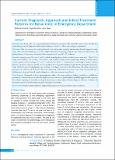Please use this identifier to cite or link to this item:
https://hdl.handle.net/20.500.14356/1620| Title: | Current Diagnostic Approach and Initial Treatment Patterns for Renal Colic in Emergency Department |
| Authors: | Shrestha, Roshana Bista, Yogendra Khan, Amir |
| Citation: | ShresthaR., BistaY., & KhanA. (2017). Current Diagnostic Approach and Initial Treatment Patterns for Renal Colic in Emergency Department. Journal of Nepal Health Research Council, 15(1). https://doi.org/10.33314/jnhrc.v15i1.969 |
| Issue Date: | 2017 |
| Publisher: | Nepal Health Research Council |
| Article Type: | Original Article |
| Keywords: | Hematuria Hydronephrosis Nephrolithiasis Pyuria Renal colic Ureteric colic Urolithiasis |
| Series/Report no.: | Jan-April, 2017;969 |
| Abstract: | Abstract Background: Renal colic is a common clinical presentation in emergency. The goal of this study was to describe the epidemiology, current diagnostic and treatment strategies of ureteric colic in our emergency department. Methods: This is a retrospective study performed over a six months period of patients with clinically suspected renal colic. Data collected included age, sex, urine analysis, ultrasound studies regarding size, site of the stone and presence of hydronephrosis. Comparative statistical analysis was performed using SPSS 12.2 software. Results: Among the total 201 cases, 134(67%) had ultrasound performed which yielded ureteric stone in 61/134 (45.5%) cases, out of which 52.5% (32/61), 32.8% (20/61) and 14.8% (9/61) had stones measuring 5-9.9mm, ≤ 4.9mm and ≥ 10mm respectively. The mean age was 31.6±11 with male: female of 3:1. Hydronephrosis was strongly correlated with the presence of ureteric stone (sensitivity -85.2%, specificity-94.5%, positive predictive value-92.9% and negative predictive value of 88.5%) and was significantly more common with larger stones (p=0.05). Hematuria and pyuria was present among 44.3% (27/61) and 31.1% (19/61) of the ultrasound confirmed ureteric stones respectively. Nonsteroidal anti-inflammatory drugs and smooth muscle relaxants were the most common drug offered. Conclusions: Ultrasound to detect hydronephrosis, which is the most significant finding, may help to establish the probability of obstruction due to clinically important stone. Absence of hydronephrosis probably suggests small or passed out calculus requiring no immediate urological intervention or may indicate alternate diagnosis. Presence or absence of hematuria cannot be reliable diagnosing and excluding ureteral stones. Keywords: Hematuria; hydronephrosis; nephrolithiasis; pyuria; renal colic; ureteric colic; urolithiasis. |
| Description: | Original Article |
| URI: | http://103.69.126.140:8080/handle/20.500.14356/1620 |
| ISSN: | Print ISSN: 1727-5482; Online ISSN: 1999-6217 |
| Appears in Collections: | Vol. 15 No. 1 Issue 35 Jan-Apr 2017 |
Files in This Item:
| File | Description | Size | Format | |
|---|---|---|---|---|
| 969-Manuscript-1874-1-10-20170608.pdf | Fulltext Download | 212.31 kB | Adobe PDF |  View/Open |
Items in DSpace are protected by copyright, with all rights reserved, unless otherwise indicated.
